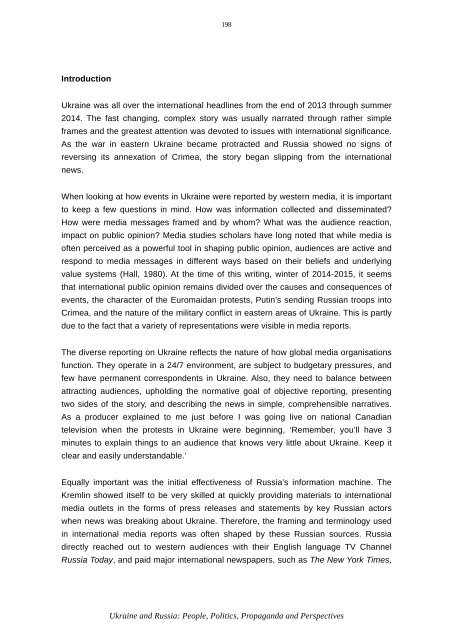Ukraine-and-Russia-E-IR
Ukraine-and-Russia-E-IR
Ukraine-and-Russia-E-IR
You also want an ePaper? Increase the reach of your titles
YUMPU automatically turns print PDFs into web optimized ePapers that Google loves.
198<br />
Introduction<br />
<strong>Ukraine</strong> was all over the international headlines from the end of 2013 through summer<br />
2014. The fast changing, complex story was usually narrated through rather simple<br />
frames <strong>and</strong> the greatest attention was devoted to issues with international significance.<br />
As the war in eastern <strong>Ukraine</strong> became protracted <strong>and</strong> <strong>Russia</strong> showed no signs of<br />
reversing its annexation of Crimea, the story began slipping from the international<br />
news.<br />
When looking at how events in <strong>Ukraine</strong> were reported by western media, it is important<br />
to keep a few questions in mind. How was information collected <strong>and</strong> disseminated?<br />
How were media messages framed <strong>and</strong> by whom? What was the audience reaction,<br />
impact on public opinion? Media studies scholars have long noted that while media is<br />
often perceived as a powerful tool in shaping public opinion, audiences are active <strong>and</strong><br />
respond to media messages in different ways based on their beliefs <strong>and</strong> underlying<br />
value systems (Hall, 1980). At the time of this writing, winter of 2014-2015, it seems<br />
that international public opinion remains divided over the causes <strong>and</strong> consequences of<br />
events, the character of the Euromaidan protests, Putin’s sending <strong>Russia</strong>n troops into<br />
Crimea, <strong>and</strong> the nature of the military conflict in eastern areas of <strong>Ukraine</strong>. This is partly<br />
due to the fact that a variety of representations were visible in media reports.<br />
The diverse reporting on <strong>Ukraine</strong> reflects the nature of how global media organisations<br />
function. They operate in a 24/7 environment, are subject to budgetary pressures, <strong>and</strong><br />
few have permanent correspondents in <strong>Ukraine</strong>. Also, they need to balance between<br />
attracting audiences, upholding the normative goal of objective reporting, presenting<br />
two sides of the story, <strong>and</strong> describing the news in simple, comprehensible narratives.<br />
As a producer explained to me just before I was going live on national Canadian<br />
television when the protests in <strong>Ukraine</strong> were beginning, ‘Remember, you’ll have 3<br />
minutes to explain things to an audience that knows very little about <strong>Ukraine</strong>. Keep it<br />
clear <strong>and</strong> easily underst<strong>and</strong>able.’<br />
Equally important was the initial effectiveness of <strong>Russia</strong>’s information machine. The<br />
Kremlin showed itself to be very skilled at quickly providing materials to international<br />
media outlets in the forms of press releases <strong>and</strong> statements by key <strong>Russia</strong>n actors<br />
when news was breaking about <strong>Ukraine</strong>. Therefore, the framing <strong>and</strong> terminology used<br />
in international media reports was often shaped by these <strong>Russia</strong>n sources. <strong>Russia</strong><br />
directly reached out to western audiences with their English language TV Channel<br />
<strong>Russia</strong> Today, <strong>and</strong> paid major international newspapers, such as The New York Times,<br />
<strong>Ukraine</strong> <strong>and</strong> <strong>Russia</strong>: People, Politics, Propag<strong>and</strong>a <strong>and</strong> Perspectives


